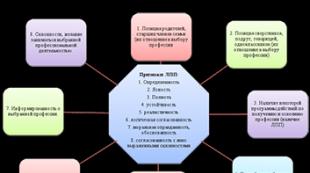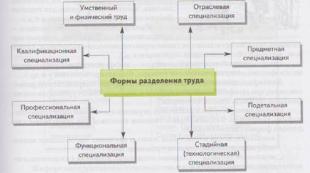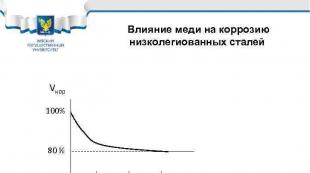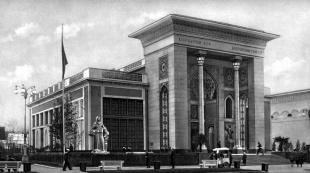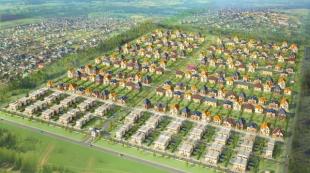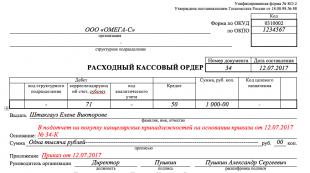Start in science. Designing a situation for choosing a profession Table choosing the optimal profession option
LESSON TOPIC: OBJECTIVE: To introduce the principle of informed choice of profession, reasonable career planning, taking into account the needs of personal self-determination in the real labor market. OBJECTIVES: Educational Developmental Lesson type: mastering new material. Type of lesson: combined. Methods: case method (compressed case), heuristic, conversation, discussion. Forms of work: frontal, group, individual.
Download:
Preview:
LESSON TOPIC: Spheres of modern production and vocational education.
TARGET: Familiarization with the principle of informed choice of profession, reasonable career planning, taking into account the needs of personal self-determination in the conditions of the real labor market.
TASKS:
Educational - to teach children to understand the essence of the sphere of modern production and its components, and independence in drawing conclusions.
Develop skills to choose the optimal career option, taking into account personal characteristics and market requirements.
Developmental - Develop skills of independent analysis and the ability to rationally choose a profession and plan a career.
Expand information about vocational education opportunities in modern conditions.
Educational - to cultivate in students a culture of working with classmates, a common culture.
Lesson type : mastering new material.
Lesson type: combined.
Methods: case method (compressed case), heuristic, conversation, discussion.
Forms of work: frontal, group, individual.
STRUCTURE AND PROGRESS OF THE LESSON:
- Introductory part -2 min. Greetings. Report the topic and order of the lesson. Issuance of the case. Explanation of the rules for working with the case. Specifying evaluation criteria.
- Independent work with a case in groups: Studying new material and updating knowledge - 5 min. Consolidating new material - 25 min. Completing and processing the test “Diagnostics of professional preferences and building a personal professional plan.” “Brainstorming” - combining research with the stability of demand for the profession. Selection analysis.
- Lesson summary. Discussion-8 min.
QUESTIONS FOR DISCUSSION:
CRITERIA FOR EVALUATION:
During the discussion, choosing the best solution to the problem. The teacher notes the work in small groups and analyzes the results of the discussion. Gives grades.
Explains homework.
D/Z: Exercise “Plus-minus-interesting.” Draw a table and describe the situation. When you get a profession and work in it as follows:
LESSON TOPIC: Spheres of modern production and vocational education.
TARGET: Familiarization with the principle of informed choice of profession, reasonable career planning, taking into account the needs of personal self-determination in the conditions of the real labor market.
TASKS:
Educational - to teach children to understand the essence of the sphere of modern production and its components, and independence in drawing conclusions.
Develop skills to choose the optimal career option, taking into account personal characteristics and market requirements.
Developmental - Develop skills of independent analysis and the ability to rationally choose a profession and plan a career.
Expand information about vocational education opportunities in modern conditions.
Educational - to cultivate in students a culture of working with classmates, a common culture.
Choosing a profession is an important stage in your life associated with determining the direction of professional training.
- Study the material on the topic and complete the assignments.
- Provide your solution to the problem.
- Listen to other participants' points of view.
The world of professions is huge, there are more than 40 thousand of them, with about five hundred new ones appearing every year and the same number disappearing or changing.
The professional-qualification division of labor (it is based on the technological division of labor) makes it possible to distinguish a profession, specialty and qualification.
The word “profession” comes from two Latin words: “professio” - officially designated occupation, specialty and “profiteor” - I declare my business. This word, like many other terms, has multiple meanings.
Profession - a type of labor activity that requires certain training and is usually a source of subsistence.
Often the problem of choosing a profession arises more than once in life. Professional self-determination occurs most early in the arts, and most lately in the sphere of politics and science.
In each specific case, the name of the profession is determined by the nature and content of the work, the tools or objects of labor used. Along with the generic concept of “profession”, there is a specific concept of “specialty”.
Specialty - (lat. specialis – special) is a complex of knowledge, skills and abilities acquired through special training and work experience, necessary for a certain type of activity within a particular profession.
A few examples. Profession: turner. Specialties: backing turner, carousel turner, semi-automatic turner, boring turner, revolver turner. Profession: machinist. Specialties - steam turbine operator, press operator, scraper operator, stage operator, etc. Profession - teacher. Specialties: teacher of physics, mathematics, chemistry, primary school, etc.
Qualification ( English quality - quality , in the sense of the degree of manifestation of merit) - in some areas this term refers either to the process of assessing the level of quality, or to the provided levels themselves.
It is important not to confuse high qualifications with higher education, because you can get it without becoming a highly qualified specialist.
Requirements that professions place on a person.
When a young person chooses a profession, he is interested in his profession being popular with employers not only today, but also in 10-20 years. This is called stability of demand for a profession.
Along with the “eternal” professions - builder, doctor, teacher, etc., the transport, chemical industry, high technology, communications, new professions at the intersection of traditional ones, economic management, and the social sphere are becoming relevant. At the same time, for professional success at the present stage of development of society, personal qualities, communication skills, a person’s motivation to work, readiness for continuous improvement of one’s professionalism, for changes become more important than the traditionally understood amount of knowledge.
An indicator of the stability of demand for a profession is the number of jobs in a particular specialty available at different enterprises in the district and region. Achieving a goal depends on a person’s desire, determination and will.
The main factors or conditions for choosing a profession are aspects of a well-founded professional plan, which takes into account the interests, abilities, state of health, abilities of the person choosing a profession and the needs of society for personnel.
General structure of vocational education in the region
A profession can be obtained in various types of educational institutions, depending on what level of professional education you choose:
Vocational education can be primary, secondary and higher.
Primary vocational educatione - represented by lyceums, vocational schools, which provide a working specialty.
Secondary vocational educationallows you to become a mid-level specialist in most executive or creative professions. Secondary vocational education can be obtained by having basic general, secondary (complete) general or primary vocational education.
At the same time, if a person already has secondary (complete) general or primary vocational education, then he can receive secondary vocational education through shortened accelerated programs.
Higher professional educationrepresented by state and non-state universities. When choosing a non-state educational institution, it is necessary to check the licenses, accreditations and certifications of the educational institution. Without the specified 3 documents, a diploma from an educational institution does not provide national guarantees of employment.
Where can you get information about professional educational institutions?
Information about educational institutions providing vocational training can be obtained:
- in reference books for applicants to educational institutions;
- in telephone directories;
- in computer information retrieval programs on the INTERNET;
- in advertisements;
- in libraries;
- in OPK;
- in regional employment centers;
- in conversations with representatives of educational institutions and teachers;
- during meetings with students and alumni;
- during personal visits to educational institutions.
Modern production includes two large areas of activity
The boundaries between the branches of material and non-material production are conditional and relative.
They are united by a common purpose - to serve the needs of people, the accumulation and improvement of human capital. In close interconnection, they form an integral structure of the national economy of the country, which, like a living organism, does not stand still, but is constantly developing and changing at present in shorter periods of time.
More and more people are employed in the field of non-material production due to the development of scientific developments, high technologies, computer information and telecommunication systems.
INDUSTRY - a set of enterprises and industries that have common products, technologies and satisfied needs.
The city where you live also constitutes a structural unit of the country's national economy, in which enterprises of certain industries are concentrated. Over the vast territory of Russia, historically the sectoral distribution is uneven across regions and regions. Same for individual cities.
Each person makes the final decision on choosing a profession independently. There are two types of errors:
- following other people's advice, choosing for the company;
- choosing a nearby university or an outwardly attractive, prestigious profession;
- lack of essential information about the profession or specialty, ignorance of one’s personal characteristics and character traits and so on.
Task No. 1. Carry out testing “Diagnostics of professional preferences and construction of a personal professional plan” (20 min.).
Below are the different professions listed in pairs. In each pair of professions, try to find the one you prefer. For example,
Of the two professions - poet or psychologist - you prefer the first, then on the answer sheet you must put a “+” sign in column 42 a).
Processing the results.
To determine what professional type you belong to, you need to count the number of answers for each of the six types. The maximum number of points shows the predominance of a certain personality type according to J. Holland's classification: 1st column - realistic type; 2nd column - intellectual type; 3rd column - social type; 4th column - conventional type; 5th column - enterprising type; 6th column - artistic type.
It is possible that you will score the same number of points for several types. In this case, it is premature to talk about a formed professional orientation.
Questionnaire by D. Holland
Process engineer | Constructor |
||
Head teacher for extracurricular activities | Chairman of the trade union committee |
||
Behind | Designer | Draftsman |
|
Chemist | Accountant |
||
Political figure | Writer |
||
Cook | Compositor |
||
Advocate | Editor of a scientific journal |
||
Educator | Ceramic artist |
||
Knitter | Sanitary doctor |
||
10a | Notary | Supplier |
|
11a | Translator of fiction | Linguist |
|
12a | Pediatrician | Statistician |
|
13a | Store manager | Photographer |
|
14a | Philosopher | Psychiatrist |
|
15a | Computer's operator | Cartoonist |
|
16a | Gardener | Meteorologist |
|
17a | Teacher | Squad leader |
|
18a | Metal artist | Painter |
|
19a | Hydrologist | Auditor |
|
20a | Head of the household | Conductor |
|
21a | Electronics engineer | Secretary-typist |
|
22a | Chief livestock specialist | Zoologist |
|
23a | Sports doctor | Feuilletonist |
|
24a | Trolleybus driver | Nurse |
|
25a | Copyist | Director |
|
26a | Architect | Mathematician |
|
27a | Police children's room worker | Accountant |
|
28a | Chairman of the collective farm | Agronomist-seed grower |
|
29a | Biologist | Ophthalmologist |
|
ZOa | Archivist | Sculptor |
|
31a | Stenographer | Speech therapist |
|
32a | Economist | Store manager |
|
ZZa | Museum Researcher | Consultant |
|
34a | Corrector | Critic |
|
ZZa | Radio operator | Nuclear Physics Specialist |
|
Zba | Doctor | Diplomat |
|
37a | Actor | Cameraman |
|
38a | Archaeologist | Expert |
|
39a | Cutter-fashion designer | Decorator |
|
40a | Watchmaker | Installer |
|
41a | Director | Scientist |
|
42a | Psychologist | Poet |
Answer form
Personality type |
|||||
Behind |
|||||
10a | On |
||||
12a | 13a | ||||
14a | 15a | ||||
16a | 17a | 18a |
|||
19a | 20a | ||||
21a | 1 22^a | ||||
23a | |||||
24a | 25a | 26a |
|||
27a | 28a | ||||
29a | ZOa | ||||
31a | 32a | ||||
ZZa | 34a | ||||
35a | Zba | 37a |
|||
38a | 39a | ||||
40a | 41a | ||||
42a | |||||
Realistic type (R)– prefers realistic careers, working with specific objects of labor and mechanisms rather than with people. Has mechanical and engineering abilities, loves to work with tools and machines, and receives satisfaction from the concrete results of his work. Management and people skills are generally low. Experiences difficulty in expressing oneself, conveying one's feelings and thoughts to others.
Research type (I)– focused on science and scientific activity. Has mathematical and research skills. Gets more satisfaction from solving abstract problems than from translating them into practical action. Prefers to work more with ideas than with people and objects. Not inclined to leadership, avoids monotonous physical or other actions. Does not feel discomfort in situations of uncertainty and does not like strictly structured activities with many rules.
Artistic type (A)– prefers to work in an artistic environment that offers many opportunities for self-expression through artistic means. Show little interest in problems that require serious organizational preparation for their solution, or the application of significant effort, preferring those that can be solved through self-expression in the artistic sphere. Enjoys creating creative works, has a good imagination, creative abilities.
Social type (S)– prefers social careers, is focused on interacting with people, likes to help people and solve their problems. Expresses himself well and expresses himself with others, loves attention and seeks situations that allow him to be the center of attention of the group. Avoids activities that require mechanical, repetitive actions.
Entrepreneurial type (E)– activities related to influencing people, organizing them to solve certain problems. They have leadership and oratorical speaking abilities. They are competitive-oriented and often demonstrate verbal aggression. They get satisfaction from the opportunity to be in the center of attention, events, and convince others of their point of view. High claims to power and material wealth. They highly value leadership and economic abilities, business qualities, but are aesthetically poorly developed.
Traditional type (E)– prefers to work with data and information, to work on processing and systematizing information. He is prone to order, strives to organize and structure the surrounding reality. Avoids areas of activity related to convincing people. Feels comfortable accepting the role of a participant in a certain structure. Has counting and clerical skills.
Task No. 2. “Brainstorming” (5 min.) According to the chosen professional type, indicate possible options for professions and determine the most stable one on the labor market. Justify your choice.
QUESTIONS FOR DISCUSSION:
- Define the concepts: profession, specialty, qualification, industry.
- What areas does modern production include?
- How to determine for yourself a sphere of professional activity that would be useful to society and would bring you material and spiritual satisfaction?
- Which industries are developing most dynamically?
- What professions and specialties will be in demand by the time you enter working life?
CRITERIA FOR EVALUATION:
1. Professional competent solution to the problem-10b
2. Brevity and clarity of presentation of the theoretical part of the solution to the problem - 10b.
3. The quality of the graphic part of the solution to the problem - 10.
4. Ethics of discussion-5b.
5. Speed of task completion - 5b.
40b-5 “excellent”
30b-4 “good”
20b-3 “satisfactory”
10b-2 “unsatisfactory”
Everyone knows the formula for choosing a profession, consisting of three components:
- I want (your interests, inclinations, desires)
- I can (your resources - health, abilities, personal qualities)
- It is necessary (labor market requirements).
If the requirements of the labor market, the capabilities and desires of the person himself have no common ground at all, do not correspond to each other, this means that the person wants to do something that he cannot do, and even in a situation where no one needs it. Oddly enough, more than half of graduates move along this path.
If you can find a compromise between the three components, then the chances of achieving professional success increase. Interest in a profession can grow as it is mastered, and with the growth of professionalism, the competitiveness of a specialist in the labor market also increases.
The ideal option (and the rarest) - an absolute coincidence of your desires, capabilities and market requirements - provides a chance to receive a decent reward for work that brings pleasure.
Factors for choosing a profession
A personal professional plan is considered justified when there is
consistency between occupational choice factors.
Structure of a personal professional plan
1. Main professional goal (dream, life ideals at the current moment of development).
An idea of who one wants to be, what one wants to be, what one wants to achieve, what the ideals of life and activity are.
2. Short-term professional goals (as stages and ways to achieve a long-term goal).
The idea of a chain of immediate and more distant goals - “life perspective”
3. Knowledge of ways to prepare to achieve professional goals (especially those close to you) and ways to work on yourself.
Knowing yourself (knowing your capabilities to achieve your goals: near and far goals). Ideas about the internal conditions for achieving goals (awareness of one’s own motives, interests and inclinations, capabilities, learning abilities, health status).
4. Real preparation for the profession (practical implementation of plans).
Ideas about the external and internal conditions for achieving the intended goals (difficulties, possible consequences, possible opposition from certain people)
5. Backup options for goals and ways to achieve them in case of insurmountable difficulties in implementing the main options.
Life planning taking into account the likelihood of unforeseen circumstances. (There may be cases when the backup option does not coincide with the distant goal and is considered as an independent path).

Motives for choosing a profession
1) MOTIVES OF SOCIAL STATUS:
- achieve a position in society
- get a prestigious job
- live and work among educated people
2) MATERIAL AND HOUSEHOLD MOTIVES:
- have a good salary
- get a clean and easy job
3) MOTIVES FOR SELF-AFFIRMATION IN WORK:
- realize your abilities
- get an attractive job you like
4) MOTIVES FOR PROFESSIONAL EXCELLENCE:
- acquire deep professional knowledge
5) MOTIVES FOR OWN WORK:
- get an interesting specialty
6) MOTIVES FOR THE SOCIAL SIGNIFICANCE OF WORK:
- benefit people, society
- get a profession that makes it easier to find a job
7) MOTIVES FOR OBTAINING HIGHER EDUCATION:
- get a diploma of education
- become a cultured, educated person
8) INDIFFERENT MOTIVES:
- you just need to get some kind of profession
Mistakes in choosing a profession
INSUFFICIENT KNOWLEDGE ABOUT THE WORLD OF PROFESSIONS:
- Outdated ideas about the nature and conditions of work in a particular profession.
- Passion only for the external side of the profession (prestige, attractiveness, popularity).
INCORRECT ASSESSMENT OF YOUR ABILITIES AND CAPABILITIES:
- Inability to correlate individual characteristics and abilities with the requirements of the profession.
- Replacing abilities with positive personal qualities.
- Focus on professions of only low or high qualifications.
- Uncertainty of desires and life goals.
INABILITY TO UNDERSTAND THE RULES FOR CHOOSING A PROFESSION:
- Transferring the attitude towards a person - a representative of a profession - to the profession itself.
- Identification of an educational subject with a profession.
- Choosing a profession “for the company.”
“My professional choice” (exemplary creative project on professional self-determination)
So that you can better understand the theoretical material on professional self-determination and be able to practically apply the knowledge gained, read the sample project of professional choice. It is composed of 20 sequential operations - steps. Each step contains a description of the steps to determine professional suitability and recommendations for their implementation (in italics). The profession of computer operator was chosen as a trial one for the project.
Profession computer operator
STAGE I
Step 1: Identify the problem
For a person standing on the threshold of adulthood, issues of professional self-determination and life prospects are paramount. After all, your entire subsequent life depends on how correctly your future specialty is chosen.
Identify the problem area of your creative project.
Step 2: Awareness of the problem area
The problem area of this project is the study of the algorithm for choosing a profession and the design of ways of self-improvement using the example of the analysis of specific professional activities (Scheme 1).
Identify the sub-problems of your problem area.
Step 3: Identify a Specific Need
Everyone needs to make the right professional choice in accordance with their interests and capabilities.
Is this need a priority for you? Give detailed reasons for your answer.
Step 4: Definition of a specific task and its formulation
The objective of the project is to analyze a specific profession, identify its main requirements for a person and identify opportunities for mastering this profession.
Formulate the main objectives of your project.
STAGE II
Step 5: Identifying Key Parameters
Our task is limited to the analysis of only one area; we must check whether the parameters of the profession correspond to the personal characteristics of its applicant. This will help us understand the algorithm for analyzing the profession.
The criteria for choosing a profession should be as follows:
- the chosen profession must correspond to individual personal and psychophysiological characteristics; availability of training for a profession is necessary (presence of an educational institution, its territorial reach); material costs for obtaining a specialty must correspond to the financial capabilities of the family; demand for the profession in the labor market.
What parameters and limitations can be identified in your project?
Step 6: Identifying traditions, history, trends
The correct professional choice is based on collecting information about various professions, identifying the most in demand and promising at the present time, clarifying the traditions of the people, family, and locality (Diagram 2).
You need to identify how the requirements for training specialists in various areas of professional activity change over time. With the help of the media and the Internet, you need to find out what new specialties have appeared in recent years, what their specifics are, and in which educational institutions they are taught.
Step 7: Activity Analysis
Having familiarized yourself with various professions, it is necessary to develop a supporting scheme of reflection, consistent progress along which will help you make the right choice.
Algorithm for professional self-determination:
- identification of interests and inclinations; analysis of professional activities in accordance with interests and inclinations; identification of individual personal and psychophysiological characteristics; correlation of individual characteristics with the requirements of professional activity; determination of socio-economic factors for choosing a profession: ways and conditions for obtaining vocational education, material costs for training; professional test; professional plans and prospects; program and development.
Based on this algorithm, draw up and analyze your basic thinking scheme according to which you will choose a profession. It may take the form of a diagram (Scheme 3).
Step 8: Developing ideas, options, alternatives
First, let's determine the area of professional activity that is most preferable. This can be done using the methods
“Differential Diagnostic Questionnaire” (DDI) or “Professional Readiness Questionnaire” (OPG), which can be found on the Internet. Based on the results obtained, we choose one of five spheres of professional activity (man - technology; man - nature; man - man; man - sign system; man - artistic image). The professional activity considered in our project lies in the sphere of “person - sign system”.
Using Internet sites that provide descriptions and characteristics of professions, we will list a number of specialties belonging to the chosen field of professional activity: webmaster, computer operator, programmer, system administrator, computer science teacher, dispatcher.
Using DDO or OPG methods, determine your field of professional activity and read the descriptions of professions related to this field. Analyze the data received and select a number of specialties that attract you most.
Step 9: Determining professional requirements
Let us highlight the following parameters related to the sphere of professional activity “person - sign system”.
The work should be:
- varied; have a transformative, creative character; stimulate an increase in the level of knowledge and skills; meet the psychophysiological and social needs of a person.
Highlight the basic requirements for your future professional activity. Using techniques, identify your interests and inclinations, correlate them with the written requirements, and draw conclusions.
STAGE III
Step 10: Analysis and synthesis of ideas
Of all the professions listed in the previous step, you now need to choose the most suitable one. To do this, you need to evaluate them in points (from 1 to 5) according to the main parameters (see step 5). It is more convenient to do this by working with a table.
We did this and came to the conclusion that the most suitable profession for us is a computer operator.
Analyze the results in your table. Which specialty scored the most points? Is this the best option?
Choosing the optimal career option
Table 1
Speciality | Requirements for the specialty | Number of points |
||||
Availability of training | Demand in the labor market | Correspondence | Material costs for obtaining a profession | |||
Personal characteristics | Psychophysiological characteristics |
|||||
Webmaster | ||||||
Computer's operator | ||||||
Programmer | ||||||
System Administrator | ||||||
Teacher computer science | ||||||
Dispatcher |
Step 11: Studying the content of future professional activity
So, we have made the choice of the optimal variant of work activity. In order to learn more deeply about the content of the future profession, it is necessary to draw up its professionogram and psychogram. Such work will allow you to better determine your professional suitability for it.
Step 12: Identifying Individual Characteristics
Identify your individual personal and psychophysiological characteristics using methods selected for each area of professional activity. In our case, these are methods for the professional field “Man is a sign system.” Next, correlate individual characteristics with the professional requirements described in step 9.
Using the tests given in the textbook and on the Internet, determine your type of temperament, character and other personal characteristics. With the help of a school psychologist and a doctor, identify the psychophysiological characteristics of your development. Do they meet the requirements outlined in step 9?
Step 13: Determining career paths and choosing a place to study
Use a reflection framework to complete this step. In the center of the diagram it is necessary to place possible ways of obtaining a profession and indicate factors and conditions that should be taken into account when solving this problem. You can discuss this with parents, teachers, counselors.
Paths to obtaining a profession depend on the educational institution you choose. Let's say you decide to first get a secondary education in your chosen specialty at a college, and then continue your studies at a university in an abbreviated manner.
Use the diagram in Figure 85, which shows the factors and conditions taken into account when choosing a place of study.
What ways of obtaining your chosen profession do you know? Which one attracts you the most? Analyze each point of this scheme and identify several educational institutions where you can get this profession. Having chosen a place of study, consider your options for further actions in the event of failure to enroll in the intended educational institution.
Step 14: Professional Test
At the third stage, we examined in detail all the characteristics of the chosen profession, as well as our psychological characteristics. Now, having the appropriate theoretical training, you can conduct a professional test. This will ensure that the profession is completely suitable.
Is it possible to conduct a professional test for your chosen profession? If yes, then indicate where, at what time and under what conditions the work will take place. If a professional test has already been carried out, then analyze its results. The creative projects you have completed, the models you have created in technical and arts and crafts circles, are a type of professional audition. Consider their results.
Step 15: Correction
After passing a professional test, we can draw a conclusion about whether we should go to study in this specialty or choose another. Perhaps the training profile in .
If you want to make changes to your selection, you should go back to step 5 or 7 and make the changes. What conclusions did you draw?
Step 16: Predicting your future professional career
Now that we are convinced that the chosen profession is completely suitable for us, we can make a forecast of future professional growth and career. To do this, it is recommended to develop an individual program of self-improvement and development, in accordance with which professional growth will be built.
Create an individual program for self-improvement and development. What success do you want and can achieve in your future profession? Reflect all your professional plans and thoughts in the form of a forecast of professional growth and career. There is no single path, so you can consider different career options.
V STAGE
Step 17: Control
It is necessary to return to steps 5 and 7 and compare the completed project with the one that was intended. If there are shortcomings, they can always be eliminated.
Record your results.
Step 18: Decoration
We draw up the finished project in the form of sequential actions - steps. They should reflect all the thoughts that arose during the choice of profession. In the finished project we include diagrams and drawings that helped us make our choice.
Design your project in accordance with the example provided.
Step 19: Self-Esteem
Let's return to steps 2, 4 and 7. After analyzing them, you can try to evaluate yourself (Table 1).
If you are completely satisfied with the results obtained during the course, it means that you were able to successfully develop the idea of the project and can now bring it to life. For this purpose, we recommend using an approximate assessment of readiness for professional choice according to the methodology (Table 1)
Self-monitoring map of readiness for professional self-determination
table 2
Criteria and indicators | Score in points |
Life plan and professional intentionsI am aware of the meaning and purpose of my life - vaguely. My attitude towards various types of labor and work is always positive, good. I believe that a profession in a person’s life can make a person happy At the moment I have chosen a profession - definitely I know where to go after - definitely Your parents agree with your choice of profession What prompted you to choose this particular profession - knowing that the profession matches your capabilities. The presence of a professional ideal is a definite professional ideal (there is such a person) |
|
Knowledge of future profession - informationI know how to achieve success in my chosen profession - exactly. Knowledge of sanitary, hygienic and economic working conditions in the chosen profession is accurate. Knowledge of the requirements of the chosen profession for a person is accurate. Having experience in your chosen profession - observing the work of others. Availability of initial professional knowledge - acquired. Knowledge of the method of acquiring a profession (I know where and how long to study for this profession) is accurate. Knowledge of prospects for professional growth (I know how a professional career is built) - for sure |
|
Knowing your professional capabilities Interest in a future profession - the chosen profession corresponds to professional interest. Having the ability for the chosen type of work (I can prove that I have the ability for this profession) - the ability is there. I don’t know whether the natural properties of the nervous system and temperament correspond to the requirements of the chosen profession (I am fast, efficient, and energetic enough to do this work). Compliance of character traits with the requirements of the chosen profession - correspond. I don’t know whether the characteristics of mental processes (I have sufficiently developed attention, memory, thinking, imagination, etc.) correspond to the requirements of my chosen profession. Compliance of the state of health with the requirements of the chosen profession - corresponds. The nature of self-esteem (how you feel about yourself) - I don’t know. Availability of knowledge in general education subjects directly related to the future profession - in these subjects the grades are “4” and “3” |
|
The result was 64 points. This is a high level of readiness for professional self-determination.
Step 20: Protecting the Project
Preparation plan for professional choice
table 2
Events | |
1. Clarify your life orientations |
|
2. Gain experience working on a computer, gain initial professional knowledge by studying for the profile “Computer Operator” |
|
3. Clarify the compliance of the properties of the nervous system with the requirements of the chosen profession |
|
4. To clarify the compliance of the characteristics of visual perception and presentation, attention, memory, imagination, speed and accuracy of movements, emotional-volitional stability with the requirements of the chosen profession |
|
5. Find out the level of development of self-esteem |
|
6. Start studying mathematics in more depth |
|
7. Get professional advice |
|
8. Take a tour of the PU |
Using your computer, prepare to defend your project by creating a presentation plan.
Sources of information used in the implementation of the project
Textbook "Technology" for students. Internet resources.Condition for optimal choice of profession
I WANT - aspirations of the individual (desires, interests, inclinations, ideals).
CAN - personality capabilities (health status, abilities, level of knowledge, character, temperament).
NEED - society's needs for personnel, and awareness of the need to expend certain efforts to achieve vital goals.
When planning your professional career, it is useful to answer the following questions:
· What skills and abilities do you get the most satisfaction from?
· What are your main interests and favorite pastimes?
· What are your favorite academic subjects?
· What would you like to do every day for 8 hours, year after year?
· What is your dream job?
· How do you imagine your occupation in 10 years?
· What would be your ideal job? Describe it in as much detail as possible. Imagine yourself in this job, who do you work with, how do you spend your time?
· What are your criteria for choosing a profession? (required and desirable)
· What are your strengths and skills that best qualify you for the job that seems ideal to you?
· What gaps in your knowledge and skills do you need to close to get your ideal job?
· If your ideal job is currently unattainable, what kind of work could you do to move in your chosen direction?
· Who can I consult to get information useful for career planning?
· Finally, write down your immediate and long-term career goals and take action.
Temperament and style of activity
Each student must make a choice where he will continue his education after school. And in order not to make mistakes, you need to take into account your individual characteristics. Such individual characteristics as interests and inclinations are very fickle and changeable. Therefore, their development needs to be stimulated. However, there is another type of individual characteristics that practically cannot be changed, but it is also impossible not to pay attention to them, since they affect activity, behavior, and relationships with others. These characteristics include temperament.
Temperament is a set of properties that characterize the dynamic features of the course of mental processes and human behavior, their strength, speed, occurrence, cessation and change.
Today there are several different typologies of temperament, but the most commonly observed are the four types that are known to us from the classical teaching of temperaments: sanguine, choleric, phlegmatic and melancholic. In most cases, people combine traits of all four types of temperament, one of which is more pronounced and the others less pronounced. We can talk not about temperament, but about a “temperamental structure,” which includes all types.
Temperament directly affects the style of work, although the degree of its influence on work depends on production conditions and the preparedness of the worker or student for this type of work and its focus.
Work style is a set of employee behavior patterns at work, expressed in determination, interest, duration of work, the pace and productivity of work, the rhythm of the work process, and demands on the quality of work results.
Sanguine
Can be reliable in any work except automatic, monotonous and slow. He is more capable of lively, mobile activities that require ingenuity, resourcefulness and activity. A sanguine person is usually purposeful, works not for the sake of the work itself out of necessity, but with a specific goal to achieve what he wants, and persistently and patiently achieves the intended result. But this determination and perseverance is manifested by him when the work is varied and satisfies his tendency to change impressions. In all matters he is moderately restrained and calm. However, he does not tolerate interference in his work from anyone else. In the event of such delays in work, he often “gives up” and shows indifference to the matter and even apathy.
Choleric
Most successfully performs work with a pronounced cyclic nature, where during some periods of the work cycle maximum effort is required, and then the activity is replaced by calmer work of a different nature until the next cycle. But over time, he can adapt to a uniform rhythm of work, which he masters well, and will have constant success in it. It should be borne in mind that choleric temperament, more than others, contributes to tension when performing dangerous and responsible actions in which certain inaccuracies are allowed. Therefore, it is very important to encourage and strengthen his confidence in success. He has poor self-control. In cases of failure - and he often has them during the training period - he can make rash decisions. Cholerics are prescribed activities that allow them to establish a normal order in work and rest, moderately active work, since tiring physical and mental activities are unfavorable for representatives of this type of temperament. At the same time, they should not choose a profession that requires a sedentary lifestyle, as well as occupations associated with prolonged exposure to fire (forges, stoves) and, in general, with high temperatures, since this is also harmful to their health.
Phlegmatic person
The most appropriate type of educational and production work is where there is no need to quickly perform dexterous and varied actions. A phlegmatic person starts work slowly, but prepares for it in detail, not letting anything escape his attention. It takes a relatively long time to get into a normal rhythm. The pace of work is not fast. However, thanks to thorough preparation for work, perseverance and perseverance, his work productivity can be quite satisfactory. He is demanding of the quality of his work, but does not strive to do more or better than is required of him. Not inclined to change types of activities and their goals. More inclined to monotonous work that he has mastered well. The phlegmatic person has to be hurried. And at the same time, taking into account his tenacity and perseverance in work, as well as the fact that even without prodding he works with great, although not clearly expressed, tension, he cannot be reproached for slowness, because this property of his does not depend on his will. He needs to be hurried, helping and encouraging, but not depriving him of independence in actions and not overly patronizing him.
Melancholic
In terms of emotional excitability and impressionability, he is the complete opposite of a phlegmatic person. Some similarity can be seen only in their sluggish response to stimuli coming from the environment and in the slowness of actions, although the reasons for their lethargy and slowness are different. He can work quite successfully in a calm and safe environment that does not require him to quickly react and frequently change the nature of his activity. However, for a long time, experiencing grievances and even minor “pricks” of pride, he is often distracted in his thoughts from the work at hand, allowing inattention and mistakes, therefore he gets used to the normal rhythm of work slowly and does not retain it for long as a result of periodic appearances of apathy and lethargy. The pace of work is inconsistent. The productivity of labor can be very high when the mood is cheerful and low when the mood is depressed. Prefers to work alone. Thanks to his high sensitivity, he easily grasps and understands subtleties in the behavior of people, the world around him, as well as in art, literature, and music. A melancholic person is suitable for work that requires attention, the ability to delve into and work out the smallest details. Activities that require significant stress and are associated with surprises and complications are contraindicated for him.
It should be noted that any group of people works more effectively if it contains representatives of all temperaments. Melancholic people are the first to sense in which direction the search should begin. Choleric people perform the functions of fearless scouts. Sanguine people are a source of positive emotions and constantly generate unexpected ideas. Phlegmatic people analyze information and offer an informed decision.
Thus, the influence of the properties of the nervous system (strength, mobility, balance) and the associated typological characteristics of the individual on the motivation of activity is manifested in the fact that people with a certain temperament show a preference for a certain type of professional activity.
Send your good work in the knowledge base is simple. Use the form below
Students, graduate students, young scientists who use the knowledge base in their studies and work will be very grateful to you.
Similar documents
Justification (criteria) for choosing the future profession of a civil servant. Identification of interests, abilities, communicative and organizational inclinations, professional motives. Contents of activities, requirements for the future profession.
abstract, added 11/09/2011
Motivation for choosing a profession, centuries-old stages of professional self-determination and factors influencing it. Seven steps for choosing the right profession. A study of the psychological characteristics of high school students and the influence of advertising on determining a specialty.
course work, added 07/04/2010
The concept of professional suitability, the main factors in choosing a profession. Basic requirements of teenagers for their future specialty. Psychological techniques for young people when choosing a profession, types of professional selection. The purpose of human life and personality.
test, added 01/16/2011
Motives for choosing the activity of a psychologist. Scenario prerequisites for choosing a profession. Early decisions as formulas of behavior formed in response to parental messages. Evidence of the existence of a connection between an individual’s early decisions and his choice of profession.
thesis, added 02/02/2017
Specifics of the profession "psychologist". The main principle of choosing a profession. Sociogram as a method of drawing up a diagram of intra-group relationships, based on the preferences of group members. The main features and specifics of compiling an objectogram and chronogram.
abstract, added 02/01/2012
The problem of professional and personal self-determination in high school age. An empirical study of the personal characteristics of high school students who made and did not make a choice of a future profession. Interpretation of research results.
thesis, added 05/01/2011
Motives for choosing a profession. Forms of influence of a profession on a person. Deformation of a person’s internal and physical qualities under the influence of profession. Physico-somatic signs of people of various professions. Factors determining professional choice.
abstract, added 10/10/2011
Characteristics of the components of motivation: motive, need, goal, personality. Studying the professional motivation of first-year students of the Faculty of Humanities. Comparative analysis of the motives for choosing a profession among psychology students and sociology students.
presentation, added 08/19/2013
